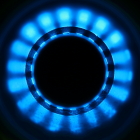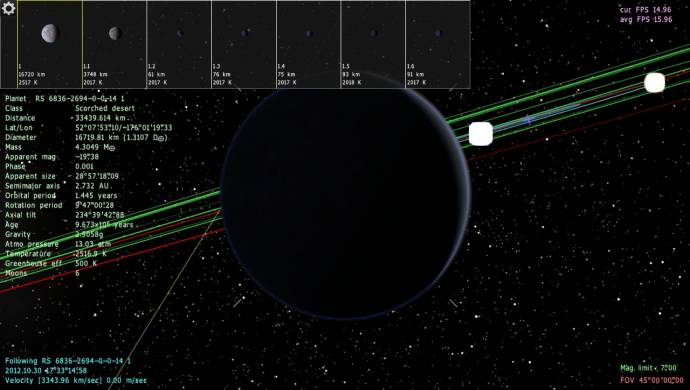|
Comets
|
|
| dave | Date: Friday, 26.10.2012, 15:18 | Message # 16 |
|
Space Tourist
Group: Users
 United States
United States
Messages: 35
Status: Offline
| Out with the new version!! pllzzz. Kidding, take your time.
|
| |
| |
| DoctorOfSpace | Date: Friday, 26.10.2012, 17:49 | Message # 17 |
 Galaxy Architect
Group: Global Moderators
 Pirate
Pirate
Messages: 3600
Status: Offline
| Really like the look of those comets.
Intel Core i7-5820K 4.2GHz 6-Core Processor
G.Skill Ripjaws V Series 32GB (4 x 8GB) DDR4-2400 Memory
EVGA GTX 980 Ti SC 6GB
|
| |
| |
| smjjames | Date: Friday, 26.10.2012, 19:02 | Message # 18 |
|
World Builder
Group: Users
 United States
United States
Messages: 913
Status: Offline
| Quote (curiousepic) How common would actively evaporating planets be, realistically?
Hot jupiters are uncommon, but not rare, however I don't know how many known ones would count as evaporating. They (evaporating planets that is, not just hot jupiters) would be more common around hotter stars of course.
The diamond planet at 55 Cancri and the recently discovered Alpha Centauri planet would count as well.
Quote Can planets with highly elliptical orbits dynamically be evaporating or not, depending on distance?
Considering his answer to a question of mine that is asking the same kind of thing, I would guess yes.
I'm curious to see what the dynamics would be in multiple star systems with widely separated orbits since such comets would be thrown all over the place.
That planet that I found colliding with one of it's stars would look awesome in a timelapse as it approached it's doom.

Edited by smjjames - Friday, 26.10.2012, 19:36 |
| |
| |
| Salvo | Date: Friday, 26.10.2012, 19:29 | Message # 19 |
 Star Engineer
Group: Local Moderators
 Italy
Italy
Messages: 1400
Status: Offline
| Simply AMAZING!!!!
But I think the tails are too much big, don't you think? 
The universe is not required to be in perfect harmony with human ambition.
CPU: Intel Core i7 4770 GPU: ASUS Radeon R9 270 RAM: 8 GBs
(still don't know why everyone is doing this...)
Edited by Salvo - Friday, 26.10.2012, 19:33 |
| |
| |
| HarbingerDawn | Date: Friday, 26.10.2012, 19:42 | Message # 20 |
 Cosmic Curator
Group: Administrators
 United States
United States
Messages: 8717
Status: Offline
| Quote (Salvo) But I think the tails are too much big, don't you think?
Many comets' tails are a hundred million kilometers long or more, and their comas can be over a million kilometers across. So it seems realistic to me. My only point would be that the ion tails on some of those comets look just a little too bright. But it's a minor observation.
All forum users, please read this!
My SE mods and addons
Phenom II X6 1090T 3.2 GHz, 16 GB DDR3 RAM, GTX 970 3584 MB VRAM
|
| |
| |
| smjjames | Date: Friday, 26.10.2012, 19:58 | Message # 21 |
|
World Builder
Group: Users
 United States
United States
Messages: 913
Status: Offline
| Yea the comets look fine to me. The second planets tail seems rather spread out (compared to the third planet), but there could be various things contributing to that such as the planets size and any moons that it has could be adding to the spread of it.
I'm not saying that it looks implausible since a comet could have a wide tail like that, but I'm not sure what would be making it do that.

|
| |
| |
| Disasterpiece | Date: Friday, 26.10.2012, 22:27 | Message # 22 |
 World Builder
Group: Users
 United States
United States
Messages: 640
Status: Offline
| This is amazing. Coupled with some planet destruction and collision checking capabilities I think I would give up eating for a few days as to not miss out on Spaceengine time.
I play teh spase engien
|
| |
| |
| smjjames | Date: Friday, 26.10.2012, 22:36 | Message # 23 |
|
World Builder
Group: Users
 United States
United States
Messages: 913
Status: Offline
| Quote (Disasterpiece) This is amazing. Coupled with some planet destruction and collision checking capabilities I think I would give up eating for a few days as to not miss out on Spaceengine time.
Lol, maybe we can combine Ubox3 and the next release of SE? You know, physics awesomeness + graphics and procedural awesomeness. 

|
| |
| |
| Antza2 | Date: Saturday, 27.10.2012, 14:24 | Message # 24 |
 World Builder
Group: Global Moderators
 Finland
Finland
Messages: 1049
Status: Offline
| Hmmm. What if a planet or a comet passes between binary stars?
Go to antza2.deviantart.com for cool photos!
|
| |
| |
| Salvo | Date: Saturday, 27.10.2012, 14:54 | Message # 25 |
 Star Engineer
Group: Local Moderators
 Italy
Italy
Messages: 1400
Status: Offline
| Quote (HarbingerDawn) Many comets' tails are a hundred million kilometers long or more
Didn't knew that 
EDIT: 100th message!! 
The universe is not required to be in perfect harmony with human ambition.
CPU: Intel Core i7 4770 GPU: ASUS Radeon R9 270 RAM: 8 GBs
(still don't know why everyone is doing this...)
Edited by Salvo - Saturday, 27.10.2012, 14:54 |
| |
| |
| smjjames | Date: Saturday, 27.10.2012, 17:16 | Message # 26 |
|
World Builder
Group: Users
 United States
United States
Messages: 913
Status: Offline
| Quote (Antza2) Hmmm. What if a planet or a comet passes between binary stars?
Good question. 
I suppose the logical answer would be that the tail would go in the combined opposite direction of the two stars, or if the object is closer to one star than another, have the direction be mainly dictated by the closer star.
I know SE is set to have planets be no closer than it would reach 2000k at any point (highly elliptical orbits and binaries can create exceptions to this), but it would be cool to allow a certain percentage of the comets come very close to their primary star (or stars).
Also, will there be a melted surface subtype for each procedural model of rocky planet (or at least the ones that would exist in the inner system)?

|
| |
| |
| Salvo | Date: Sunday, 28.10.2012, 08:21 | Message # 27 |
 Star Engineer
Group: Local Moderators
 Italy
Italy
Messages: 1400
Status: Offline
| There are Chthonian planets on Space Engine? Because an evaporating planet will become a Chtonian planet someday 
The universe is not required to be in perfect harmony with human ambition.
CPU: Intel Core i7 4770 GPU: ASUS Radeon R9 270 RAM: 8 GBs
(still don't know why everyone is doing this...)
Edited by Salvo - Sunday, 28.10.2012, 08:22 |
| |
| |
| Aerospacefag | Date: Sunday, 28.10.2012, 12:49 | Message # 28 |
 Pioneer
Group: Users
 Russian Federation
Russian Federation
Messages: 401
Status: Offline
| After two days, I'm recovering my ability to communicate, so I can make some notes on the new feature.
Well, I asked about that for about a 8 month ago, although I never expected something like evaporating planet tails.
Quote (Salvo) But I think the tails are too much big, don't you think?
Seems that it is not that the tails are too big, but they're too bright, probably, a luminosity needs to be tweaked.
|
| |
| |
| Quontex | Date: Monday, 29.10.2012, 05:34 | Message # 29 |
 Explorer
Group: Users
 Australia
Australia
Messages: 155
Status: Offline
| Quote (Salvo) There are Chthonian planets on Space Engine? Because an evaporating planet will become a Chtonian planet someday

|
| |
| |
| smjjames | Date: Tuesday, 30.10.2012, 18:44 | Message # 30 |
|
World Builder
Group: Users
 United States
United States
Messages: 913
Status: Offline
| Quote (Quontex) Quote (Salvo)
There are Chthonian planets on Space Engine? Because an evaporating planet will become a Chtonian planet someday
I do not believe so, I hope Space Engineer adds them with maybe some other planet classes
We don't have those yet, but this is definetly a stepping stone towards adding them.
While I know that this planet either wouldn't exist, or if it did, it would be glowing hot and molten anyway, whether that planet should exist as formed yet* isn't my question. My hypothetical question is that with the new 'melted surface' planets at a temperature of 2000k+ (or 1500+? or whatever you set the temperature mark as for the surface melting), how would that be applied to asteroids and selenas?

*Space Engineer, you talked about planetary formation on another thread (or maybe it was the work in progress thread) and had said about limiting planet formation for very short lived stars or something, are you still doing that? Those aren't your exact words, but it was during a discussion about short lived stars and planet formation.

Edited by smjjames - Tuesday, 30.10.2012, 18:49 |
| |
| |